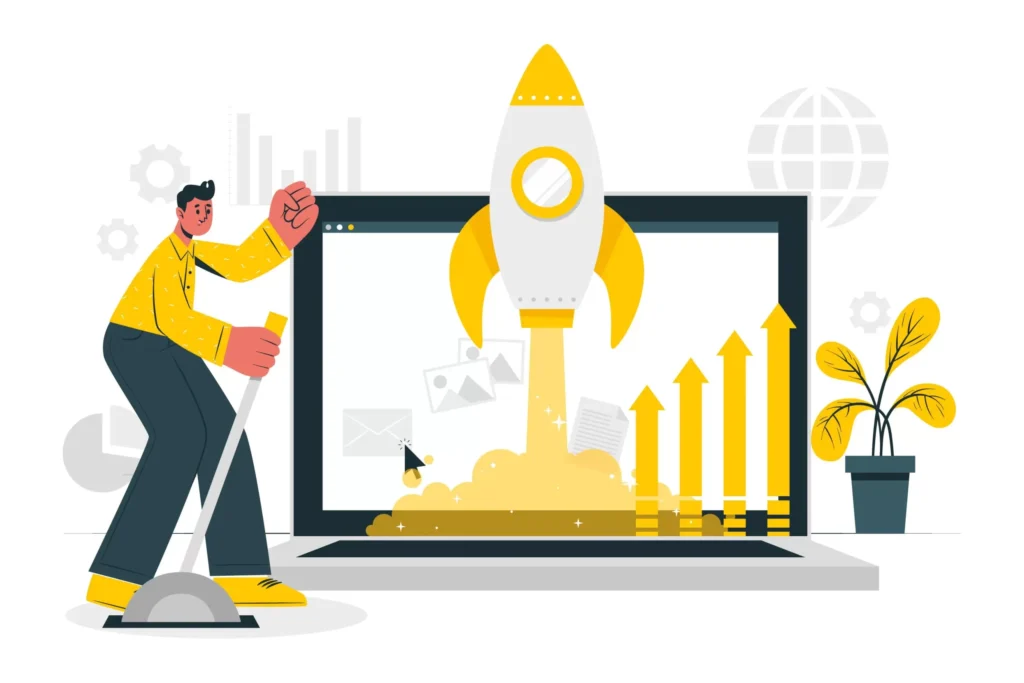Does your WordPress website feel sluggish? Are visitors bouncing off your pages because they won’t wait more than a few seconds? You’re not alone — and you’re definitely in the right place.
Website performance is a crucial ranking factor for search engines and a make-or-break element for your audience’s experience. In this comprehensive guide, we’ll walk you through everything you need to know to speed up your WordPress site, improve user satisfaction, and ultimately boost conversions. Whether you’re a blogger, business owner, or agency, this post will show you practical and proven ways to optimize WordPress performance—even if you’re not a developer.
Bonus: Grab your Free WordPress Speed Audit at the end of this post — uncover what’s slowing you down and get expert suggestions tailored to your site.
Why WordPress Performance Matters More Than Ever?
Before we dive into the strategies, let’s understand why speed matters.
According to Google, the probability of a user bouncing increases by 32% as page load time goes from 1 to 3 seconds. If your site takes more than 3 seconds to load, you’re losing traffic, leads, and potential sales — no matter how great your content or product is.
Speed is also a confirmed Google ranking factor. In simpler terms, a slow website can drop your position in search results, reduce visibility, and directly affect your organic traffic. But that’s not all — performance also affects user behavior. A faster site leads to:
- Better engagement
- Higher time on site
- Lower bounce rates
- Increased conversions
So, if you want better SEO, happier visitors, and a site that supports your business goals, WordPress speed optimization isn’t optional — it’s essential.
What Slows Down a WordPress Site?
You don’t have to be a tech expert to identify what’s dragging your website down. Most speed problems boil down to a few common culprits:
1. Bloated Themes and Plugins
While themes add design and plugins add functionality, many WordPress sites suffer from plugin overload or use themes with unnecessary code. Every active plugin increases your site’s load time—even if you’re not using it.
What to do:
- Stick with lightweight, well-coded themes (e.g., Astra, Blocksy, GeneratePress etc.).
- Use only essential plugins. Audit your plugin list regularly.
- Avoid using multiple plugins that serve the same purpose. (eg., using multiple security plugins).
2. Unoptimized Images and Media Files
Large, high-resolution images are often the number one cause of slow websites. Many users upload images directly without compression or proper sizing, leading to longer loading times.
How to fix it:
- Compress all images using tools like ShortPixel, TinyPNG, or Imagify.
- Use proper image formats like WebP, which is smaller and faster than JPEG or PNG.
- Resize images before uploading to match your website layout.
Tip: Never upload a 4000px-wide image if it only displays at 800px!
3. Cheap or Shared Hosting
Your hosting environment is the backbone of your WordPress site. If you’re on a shared hosting plan, your site could be sharing resources with hundreds of other websites—leading to poor speed and downtime.
Solution:
- Upgrade to Managed WordPress Hosting (like Cloudways, SiteGround, or WP Engine).
- Look for hosts that offer features like SSD storage, server-side caching, and 24/7 support.
4. Too Many External Scripts
Third-party scripts like Google Fonts, social media widgets, or marketing tools can create a lag. They’re loaded from outside servers and often not optimized.
Fix it by:
- Minimizing the use of external scripts and only using what’s essential.
- Hosting fonts locally.
- Delaying the loading of non-critical scripts using performance plugins.
5. Unoptimized Database
Over time, your WordPress database fills up with junk — old revisions, spam comments, temporary data. This bloats your backend and slows down every part of your site.
Database cleanup helps you:
- Improve site speed.
- Reduce page load times.
- Optimize server response.
Use plugins like WP-Optimize or Advanced Database Cleaner to perform safe cleanups.
Want to optimize your site?
Contact us today for fast, friendly, expert help. Whether you want a free audit or a full-service solution, we’re here to help you speed up your WordPress site and grow your online presence.
How to Speed Up Your WordPress Site: Proven Steps
Now that we’ve identified the causes, let’s dive into the step-by-step process to speed up WordPress.
1. Install a Caching Plugin
Caching stores a static version of your site, so WordPress doesn’t have to regenerate it each time a user visits. This reduces server load and makes your site load significantly faster.
Best plugins to use:
- W3 Total Cache
- WP Rocket (Premium)
- LiteSpeed Cache
If you’re serious about WordPress performance, caching is a must-have.
2. Use a Content Delivery Network (CDN)
A CDN stores copies of your site across multiple servers around the globe. When a user visits your site, it loads from the nearest server, not your origin server—cutting down latency.
Top CDN services:
- Cloudflare (Free tier available)
- BunnyCDN
Combined with caching, a CDN can dramatically speed up your WordPress site, especially for international audiences.

3. Minify and Combine CSS/JS Files
Every website has stylesheets (CSS) and scripts (JavaScript), and too many of them slow your site down. By minifying (removing white space) and combining them, you reduce the number of HTTP requests and file size.
Use plugins like:
- Autoptimize
- Asset CleanUp
These tools let you control what scripts load and when—without touching code.
4. Defer JavaScript and Lazy Load Images
Not all website elements need to load at once. You can delay certain scripts or images until a user scrolls down the page.
This is called Lazy Loading, and it improves initial load speed—the time it takes before your site becomes usable.
Most performance plugins (like WP Rocket, LiteSpeed Cache) offer this feature with a simple toggle.
5. Optimize Your Homepage
Your homepage is often the first impression. If it’s slow, people won’t stick around. Make sure it’s:
- Minimalistic in design
- Doesn’t load too many posts at once
- Uses optimized images
- Caches efficiently
Remember: faster homepages mean higher engagement and lower bounce rates.
Click here to request your free WordPress Speed Audit — and unlock your website’s full potential.
Final Thoughts
A fast WordPress website isn’t just a luxury—it’s a necessity in 2025. You’re not just improving load times. You’re delivering a better experience, ranking higher in search engines, and converting more visitors into customers.
Take the first step today. Start with a speed audit, implement the tips you’ve learned here, or let us handle it for you. No matter your starting point, improving WordPress performance will lead to better results across the board.
Recap Checklist: Speed Up Your WordPress Site
- Use lightweight themes and essential plugins
- Compress and optimize images
- Upgrade hosting for better server speed
- Minify, cache, and combine files
- Install a CDN
- Clean up your database regularly
- Use Lazy Loading and script deferral
- Run regular performance tests
Want Expert Help? Get a Free WordPress Speed Audit
You’ve just learned how to speed up your WordPress site using proven strategies. But every site is different — and knowing exactly what’s slowing yours down can save you time, stress, and lost traffic.
That’s why we’re offering a 100% FREE WordPress Speed Audit.
Here’s what you’ll get:
- Personalized performance report
- Diagnosis of your site’s bottlenecks
- Actionable recommendations (what to fix, how to fix it)
- No strings attached!
Ready to upgrade your site performance? Book Your Optimization Now or talk to us about your needs.
